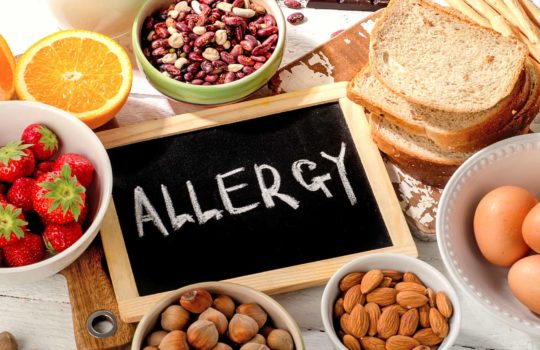The Causes And Fixes For Skin And Food Allergies

Allergies are nothing but the body’s indication of telling us about inhospitable surroundings. Allergies are caused when certain elements sensitize the respiratory and nasal passage. These cause the symptoms to flare up in response to histamine’s secretion – a hormone secreted by the body.
Allergens cause the histamine to sensitize the nasal passage and respiratory tract to react immediately, causing symptoms such as swelling, redness, sneezing, and cough, etc.
Most allergies are caused by typical food and environmental elements such as lactose, pet dandy, dust, mite, etc. Thus, they can trigger histamine’s secretion and cause various symptoms ranging from simple sneezing and cough to anaphylactic shock and breathlessness.
Amongst the various forms of allergies, skin and food allergies are extremely common. In many cases, the treatment for these allergies requires the best allergy medicine. Often swelling, inflammation, and redness in these cases might require you to take the appropriate recourse for pain relief.
What Are the Causes of Common skin allergies?
Allergies can arise due to many factors. Below are the five most common factors. Have a look!
1. Poisonous Plants
Plants and trees such as the Poison Ivy, Poison Oak, and Poison Sumac can cause rashes to erupt on your skin if you have come into their contact. When you brush past them, and if the leaves are broken, they secrete a harmful chemical oil called Urushiol that causes itchy red eruptions, rashes, bumps, or blisters.

It can be easily treated with wet compresses, calamine lotion, oatmeal baths, or hydrocortisone cream. You must visit a doctor to get checked immediately.
2. Nickel
Nickel is used in a lot of articles ranging from jewelry to eyeglass frames to paper clips. Most often, Nickel allergies are common complaints of a hairstylist, house cleaners, or any person handling metal works. The allergy results in swollen finger sides – called dyshidrotic hand eczema or pompholyx.

There is no particular treatment for Nickel allergies. A coat of nail polish on jewelry could be a possible solution. This is because it creates a barrier between the metal and the skin and prevents any allergen reaction.
3. Latex or Rubber
Latex or rubber is derived from the tree sap and is used to manufacture many articles such as gloves, erasers, balloons, etc. Often Health care workers are at the most significant risk of the allergy, the symptoms of which can go from a mild rash to severe anaphylaxis induced breathing trouble.
It is advisable to use synthetic gloves and not latex, though epinephrine (adrenaline) auto-injector can be used for treatment.
4. Clothing
Have you developed a rash after wearing a particular shirt? Allergy can also occur from certain types of dyes and chemicals used in manufacturing any clothing item. Sometimes allergens can be the fabric itself or certain mites etc.

It is essential to switch to cotton or organic cotton instead of wool or mohair to stay away from such an allergic reaction. It is also advisable to wash new clothes and rinse them well before you wear them again.
5. Preservatives and Chemical
Chemicals such as formaldehyde releasers and parabens in beauty products are significant causes of allergic reactions. To avoid this, it is essential to use mild and organic soaps and other toiletries. Paraben-free products are crucial.
This is primarily why most people are shifting to organic products that use natural ingredients and not chemicals.
What Are the Ways to Tackle Common Food Allergies?
Most common food allergies are triggered due to intrinsic immune reactions due to individual food particles. The most common allergenic food articles include certain types of fish, nuts, shellfish such as lobster, crabs, prawns, etc.
About 90% of common allergenic foods are –
1. Eggs
2. Fish
3. Milk
4. Nuts from trees
5. Peanuts (groundnuts)
6. Shellfish
7. Soya
8. Wheat
In some European countries, sesame, celery, lupin, and mustard are also top allergens.
Treatment for Food and Skin Allergies
Some of the treatment options include –
1. Elimination diet
Elimination diet doesn’t just mean not to eat a particular type of food. It may also include prohibition from inhaling, touching, or even consuming food with minute traces of such allergens. Apart from this, cutlery, crockery, cooking surfaces, etc. too must be free from any such allergy-inducing substance.
Apart from being vigilant about what they are eating, people need to steer clear of many articles. These may range from some soaps, pet food, or even glues and adhesives with traces of the allergen.
2. Medication
Medication in these circumstances is another vital treatment plane. These are used in case of emergencies where the symptoms spiral out of control, and urgent medical intervention is needed.
The primary purpose of these medications is to neutralize the symptoms induced by allergens and open up airways. This allows patients to stabilize and recuperate better from the effect of the allergy. Currently, there are two types of medication for allergic reactions, and these are –
- Anti-histamines
Histamine is a secretion of the body that sensitizes our nasal and respiratory tracts to allergens’ presence. This is the reason why the body starts immediately suppressing the effect of the allergen. The suppression and counter-action by immunity is the main reason why our symptoms lie exposed.
Anti-histamines are consumed by patients with mild to moderate allergies. Their function is to block the secretion of histamine in the body and de-sensitize the nasal and respiratory tracks. Usually, they come in all forms, shapes, and sizes, ranging from gels to liquids to tablets.
- Epinephrine
Epinephrine is used by individuals who get anaphylaxis due to food allergies. Epinephrine is an adrenalin-based injection whose work keeps up the blood pressure by easing the respiratory airway tracts and constricting the blood vessels.
Many different names know an epinephrine auto-injector, for instance, EpiPen, EpiPen Jr., Twinject, or Anapen.
Conclusion
It is essential to understand that skin and food allergies may vary from mild to moderate to extremely harsh symptoms. Despite vigilance and adherence to basic treatment and protective options, it is also important to consult a physician. Doctoral diagnosis can identify the root cause of your allergies and help you in dealing with them better.



























